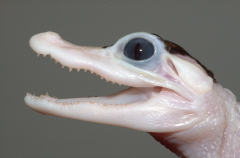 Four new creatures that are wonderfully weird
Four new creatures that are wonderfully weird
CHATTANOOGA, Tenn. – When the waters of the Amazon River recede during the dry season each year, the South American Lungfish deals with drought in an unusual way – by digging in. “It sounds weird, but Lungfish are obligate air-breathers,” said Elaine Robinson, one of the Tennessee Aquarium’s fish experts. “They can actually drown if denied access to the surface. So when their water source dries up, they burrow into the mud secreting a special mucous that keeps their skin from drying out.” Since they normally breathe air, these “fish out of water” can spend months underground until the next rainy season replenishes their river system.
Tennessee Aquarium guests will meet several new creatures and learn about many other wonderfully weird animals throughout the month of ODDtober. “This is a great time to celebrate animals that are somewhat bizarre or that display really cool behaviors,” said Thom Demas, the Aquarium’s curator of fishes. “Right now we are one of the only places where you can see Bigfin Reef Squid up close. These guys not only look like aliens, they lead pretty amazing lives.” Their “big fins” run along the lengths of their bodies, undulating to move with stealthy precision while stalking prey. If their eight arms and two tentacles don’t send a shiver down your spine, the way they peer at you will. “They have huge eyes, which when compared to their body size, are the largest in the animal kingdom,” said Demas. And, like their bizarre cousins the cuttlefish, Bigfin Reef Squid have the ability to change the color of their skin using special cells called chromatophores.
Aquarium guests will also find a new creature that’s missing most of its natural coloration. A ghostly-white baby American Alligator can be seen in the River Journey building. This animal, along with a few siblings, was recovered by the U.S. Fish and Wildlife Service last spring. “The occurance of white alligators, both leucistic and albino, is extremely rare,” said Dave Collins, the Aquarium’s curator of forests. “White hatchlings normally only survive a few days in the wild as their coloration makes them highly susceptible to predation and possible damage from sunlight.”
Leucism results from defects in pigment cells causing a lack of natural color in either all or part of the body. Albino animals have reduced pigment throughout their bodies, making their eyes appear red. Visitors will notice that this tiny gator has some pigment and normal eye color. The Aquarium also has two leucistic Alligator Gar among the massive freshwater species in the River Giants exhibit.
Another chilling species is the African Tigerfish, a recent addition to the Aquarium’s Lake Tanganyika exhibit. This top predator can often be seen patrolling the middle of this tank. Guests can easily see its razor-sharp teeth. “The Tigerfish earns its name,” said Brad Thompson, one of the Aquarium’s fish experts. “These fish have been known to stalk birds in flight from just below the surface. As the birds skim the surface to catch insects, the Tigerfish leaps out of the water to eat them. It’s truly incredible behavior. The Tigerfish is the only species of freshwater fish that I know of that has been documented catching birds in flight.”
Nearly two dozen Extraordinary Experiences will be offered free with Aquarium admission each day to introduce everyone to even more fascinating creatures. A special ODDtober cell phone audio tour will also deliver the 4-1-1 about what’s O-D-D in many other locations.
Costumed SCUBA divers will make daily appearances, even carving pumpkins underwater each Saturday in October.
Visit the Tennessee Aquarium’s website for a complete list of ODDtober programs: http://www.tnaqua.org/Oddtober Or, download the FREE Tennessee Aquarium app from the iTunes Store or Google Play.



